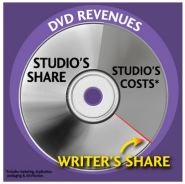Variety reported Friday that sales of DVD boxed sets accounted for $2.8 billion in sales in 2004, up from $160 million in 2000, making TV shows "the fastest growing sector of the US vid biz."
The TV DVD sector account for 18% of the US disc retail market last year…American shows dominate the DVD market not just in the US but in most Western European countries…
"In economic terms, this trend has been the equivalent for the Hollywood studi0s of striking oil in one’s own backyard, as they discovered lucrative new vehicles for exploiting brands they already own," according to the Screen Digest report.
What is the writer’s take of that gigantic windfall? About zero. Screenwriter John August crunches the numbers, using the DVD of his movie BIG FISH as an example.
the formulas used for home video residuals are based on videotapes, which are
relatively expensive to produce, and sell for a fairly low price. Technology
changes. DVDs are cheaper to produce, and sell for a higher price. But the
formula for paying residuals is still locked into the old paradigm. Studios make
a hell of lot more on each DVD they sell, but the writer (and actor, and
director) still get the same amount.
 A recent campaign
A recent campaign
by the WGA East does a graphical breakdown of the numbers, but let’s take
Big Fish as an example. According to Video Business, its
MSRP is $28.95, but most people will pay less than that. Let’s say $20, which is
what you’d pay on Amazon. And Amazon is still pulling a 25% markup at that
price; it buys the DVD wholesale at $16.
How much does it cost to manufacture, package, distribute and market each
DVD? On average, $5.45. So the studio is making a profit of $10.55 on each DVD
sold. For Big Fish, that means Columbia/TriStar has made $21.1 million
profit in just one week. Of that, the writer gets the “point-one.”
The studios refuse to give writers, actors, or directors a bigger piece of DVD revenue, not even as little as 1%, arguing they need it all to 0ff-set losses in other areas. The income from TV shows on DVD, as well as movies on DVD, more than make up for any losses incurred by short-lived shows in primetime or films that tank at the box-office (In fact, the take from movies on DVD are often much, much larger than the box-office revenues)
For TV writers, DVDs are the future of reruns, not syndication or foreign sales.
Experts quoted in the article predicted that US sales of TV shows on
DVD will reach $4.4 billion by 2009. Currently, TV shows on DVD account for 30% of all DVD purchases in Western Europe, adding up to $2.1 billion in sales.
We caved on the DVD issue in this negotiation because the studios said there was no way they’d increase our take. They declared it a non-negotiable point. So we, and all the other guilds, settled for small bumps in other areas (and we wrangled a $37 million infusion of cash into our health fund, still a pittance compared to the revenue we won’t see from DVDs).
I think it’s imperative, for the future f the WGA and the financial security of writers, that we make getting a bigger share of DVD revenue a line-in-the-sand in the next contract negotiation…that we align ourselves with our sisters unions on this issue and make it clear to the studios that we won’t accept no for an answer.
 Today at Costco I found a heck of a deal… a $16.00 DVD boxed set of three of Frank Sinatra’s crime dramas: TONY ROME, LADY IN CEMENT and THE DETECTIVE. As I’ve mentioned here before, these three films are among my guilty pleasures, especially the two TONY ROME movies. The TONY ROME movies are based on the novels by Marvin Albert, who wrote screenplays, original novels under a variety of pseudonyms (Nick Quarry, Tony Rome, Albert Conroy, Ian McCallister, Mike Barone), and movie tie-ins (including a novel based on Woody Allen’s screenplay WHAT’S NEW PUSSYCAT!)
Today at Costco I found a heck of a deal… a $16.00 DVD boxed set of three of Frank Sinatra’s crime dramas: TONY ROME, LADY IN CEMENT and THE DETECTIVE. As I’ve mentioned here before, these three films are among my guilty pleasures, especially the two TONY ROME movies. The TONY ROME movies are based on the novels by Marvin Albert, who wrote screenplays, original novels under a variety of pseudonyms (Nick Quarry, Tony Rome, Albert Conroy, Ian McCallister, Mike Barone), and movie tie-ins (including a novel based on Woody Allen’s screenplay WHAT’S NEW PUSSYCAT!)

 A recent
A recent